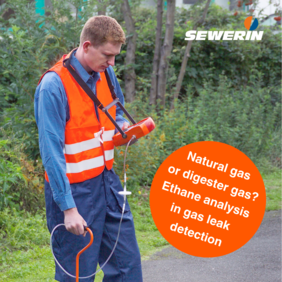Sometimes we find gas leaks that we can't explain. The measurement technology shows that the gas found is flammable, but there is no obvious damage site. Repeated measurements continue to show gas emissions. The cause could not only be a defective natural gas pipeline, but also digester or swamp gases (e.g., biogas from fermenters, landfill gas, mine gas, cemetery gas or even fuel).
Both natural gas and digester gases consist primarily of methane (CH4), which can be detected on the earth's surface using gas detectors.
Natural gas also includes hydrocarbons such as ethane (C2H6), propane (C3H8), butane (C4H10), etc.
Digester gases consist primarily of methane (CH4) and carbon dioxide (CO2), but usually have very low levels of ethane and other higher hydrocarbons, often below 0.1. %.
So, to distinguish natural gas from digester gases, we need to determine whether ethane is present in the gas sample. A portable ethane detector that is integrated into a combination measuring device (e.g., the EX-TEC® HS 680) can be used for this. The analysis takes place directly at the probe hole and works similarly to a gas chromatograph.
The gas sample is passed through a separation column with ambient air, where the gas is broken down into its components. Each gas has a specific time to pass through the separation column. If ethane is present in the sample, this will be clearly indicated.
This allows us to differentiate precisely between natural gas and digester gas and determine the cause of the gas emissions more precisely.

